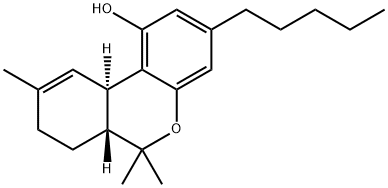DELTA9-TETRAHYDROCANNABINOL

- CAS No.
- 1972-08-3
- Chemical Name:
- DELTA9-TETRAHYDROCANNABINOL
- Synonyms
- THC;Dronabinol;TETRAHYDROCANNABINOL;Hashish;72-08-3;Marinol;DELTA-9-THC;(-)-delta9-trans-Tetrahydrocannabinol;(-)-delta(sup9)-trans-Tetrahydrocannabinol;EXO-THC
- CBNumber:
- CB0199241
- Molecular Formula:
- C21H30O2
- Molecular Weight:
- 314.46
- MOL File:
- 1972-08-3.mol
- Modify Date:
- 2025/6/13 14:48:16
| Melting point | <25 °C |
|---|---|
| alpha | D20 -150.5° (c = 0.53 in CHCl3) |
| Boiling point | bp0.02 200° |
| Density | 1.0536 (rough estimate) |
| refractive index | 1.5404 (estimate) |
| Flash point | 14 °C |
| storage temp. | 2-8°C |
| form | ethanol solution |
| pka | pKa 10.6 (Uncertain) |
| Water Solubility | 2.8mg/L(23 ºC) |
| BCS Class | 2/4 |
| CAS DataBase Reference | 1972-08-3 |
| EPA Substance Registry System | Tetrahydrocannabinol (1972-08-3) |
SAFETY
Risk and Safety Statements
| Symbol(GHS) |    GHS02,GHS06,GHS08 |
|||||||||
|---|---|---|---|---|---|---|---|---|---|---|
| Signal word | Danger | |||||||||
| Hazard statements | H225-H301+H311+H331-H370 | |||||||||
| Precautionary statements | P210-P280-P302+P352+P312-P304+P340+P311-P370+P378-P403+P235 | |||||||||
| Hazard Codes | F,T | |||||||||
| Risk Statements | 11-39/23/24/25-23/24/25 | |||||||||
| Safety Statements | 16-7-45-36/37 | |||||||||
| RIDADR | UN 1230 3/PG 2 | |||||||||
| WGK Germany | 1 | |||||||||
| HazardClass | 6.1(b) | |||||||||
| PackingGroup | III | |||||||||
| Hazardous Substances Data | 1972-08-3(Hazardous Substances Data) | |||||||||
| Toxicity | LD50 (sesame oil emulsion) in male rats (mg/kg): 800 orally; 35.5. i.v.; 672 i.p. (Rosenkranz) | |||||||||
| NFPA 704 |
|
DELTA9-TETRAHYDROCANNABINOL Chemical Properties,Uses,Production
Description
Tetrahydrocannabinol (THC) is the main active compound in marijuana. It comes from the plant Cannabis sativa (cannabis), which is a dioecious (monoecious varieties do exist) annual herb naturally found in many tropic and temperate regions of the world. Many varieties of cannabis exist, and two related species (Cannabis indica and Cannabis ruderalia) are main sources of THC. Cannabis sativa is also known as hemp, although this name is not unique to the species; its stem is a source of fiber that has been used throughout history for hundreds of applications including rope, twine, paper, and cloth. Hemp seeds are edible and high in protein. The seeds are also a source of fatty oil that can be used for food, cosmetics, medicines, and as a fuel source. Cannabis contains chemicals called cannabinoids; of the 60 cannabinoids found in Cannabis, one is THC, , which is the psychoactive ingredient in marijuana. Marijuana is produced from the leaves and fl owers of cannabis, and hashish is a resin collected from the female fl owers. The THC content, which determines the effect of cannabis drugs, varies with plant structure, variety, and preparation. Buds and fl owers specifically cultivated for drug use have greater THC content than leaves. THC content may vary from a few tenths of a percent to more than 10%, but good quality marijuana has a THC content of approximately 10%, and good hashish and hashish oils generally have THC contents between 30% and 80%.
Chemical Properties
Thick Brown Oil
History
THC was first isolated from hashish in 1964 by Raphael Mechoulam (1930–) and Yehiel Gaoni at the Weizmann Institute. In the early 1990s, the specific brain receptors affected by THC were identified. These receptors are activated by a cannabinoid neurotransmitter called arachidonylethanolamide, known as anandamide. Anandamide was named by Mechoulam using ananda, which is the Sanskrit word for ecstasy. Anandamide is thought to be associated with memory, pain, depression, and appetite. THC is able to attach to and activate anandamide receptors. These receptors are actually called THC receptors rather than anandamide receptors because researchers discovered that THC attaches to these receptors before anandamide was discovered. The areas of the brain with the most THC receptors are the cerebellum, the cerebral cortex, and the limbic system. This is why marijuana affects thinking, memory, sensory perception, and coordination.
Uses
It is the principal active constituent of cannabis. Agonist at CB1 and CB2 cannabinoid receptors. Antiemetic; appetite stimulant. Controlled substance (hallucinogen).
Definition
ChEBI: A diterpenoid that is 6a,7,8,10a-tetrahydro-6H-benzo[c]chromene substituted at position 1 by a hydroxy group, positions 6, 6 and 9 by methyl groups and at position 3 by a pentyl group. The principal psychoactive constituent f the cannabis plant, it is used for treatment of anorexia associated with AIDS as well as nausea and vomiting associated with cancer chemotherapy.
General Description
Brown amorphous semi-solid, viscous oil or chunky golden yellow solid.
Air & Water Reactions
Slightly soluble in water.
Reactivity Profile
DELTA9-TETRAHYDROCANNABINOLis very unstable to light and high temperatures. DELTA9-TETRAHYDROCANNABINOL should be protected from air during all handling due to its extreme instability. . Flammable and/or toxic gases are generated by the combination of alcohols with alkali metals, nitrides, and strong reducing agents. They react with oxoacids and carboxylic acids to form esters plus water. Oxidizing agents convert them to aldehydes or ketones. Alcohols exhibit both weak acid and weak base behavior. They may initiate the polymerization of isocyanates and epoxides.
Fire Hazard
Flash point data for DELTA9-TETRAHYDROCANNABINOL are not available; however, DELTA9-TETRAHYDROCANNABINOL is probably combustible.
Biological Activity
Cannabinoid receptor agonist (K i values are 5.05 and 3.13 nM for CB 1 and CB 2 receptors respectively; EC 50 values are 6, 0.4 and 8 nM at CB 1 , CB 2 and GPR55 receptors respectively). Major psychoactive constituent of marijuana.
Clinical Use
Dronabinol (synthetic △9-THC) i s a n antinauseant approved for the treatment of nausea and vomiting associated with cancer chemotherapy in patients who have failed to respond adequately to conventional antiemetics. A related cannabinoid, nabilone, was introduced in Canada for his indication in 1982.
Safety Profile
Poison by intraperitoneal and intravenous routes. Moderately toxic by ingestion. Experimental reproductive effects. Questionable carcinogen with experimental tumorigenic and teratogenic data. Human mutation data reported. A hallucinatory drug. When heated to decomposition it emits acrid smoke and irritating fumes. See also CANNABIS.
DELTA9-TETRAHYDROCANNABINOL Preparation Products And Raw materials
1972-08-3(DELTA9-TETRAHYDROCANNABINOL)Related Search:
1of4
chevron_right




